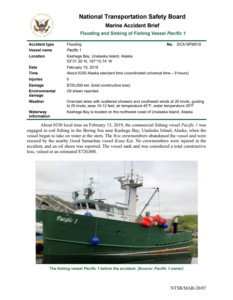NTSB issued an investigation report on the flooding and sinking of the commercial fishing vessel Pacific 1 while in the Bering Sea, Alaska, in February 2019. The report identified the master’s decision to remain at sea with continuous flooding as key cause of the sinking.
The incident
About 0330 local time on 15 February 2019, Pacific 1 was engaged in cod fishing in the Bering Sea near Kashega Bay, Unalaska Island, Alaska, when the vessel began to take on water at the stern.
The five crew members abandoned the vessel and were rescued by the nearby Good Samaritan vessel Kona Kai.
There were no injuries, but there was an oil sheen.
The vessel sank and was considered a total constructive loss, valued at about $720,000.
Probable cause
NTSB determines that the probable cause of the sinking of the fishing vessel Pacific 1 was the captain’s decision to remain at sea with continuous flooding in the lazarette from an undetermined source, which accelerated and eventually led to progressive flooding.
Findings
The Pacific 1 had several modifications in the year since its last stability analysis, which may have altered its stability characteristics.
Although the owner stated that changes were “likein-kind,” technical analysis would be required to confirm that the modified vessel met published stability guidance for the vessel.
Owners and operators should maintain an active awareness of vessel stability issues at all times, including the need for qualified individuals and naval architects to update stability instructions and booklets when structural changes are made to a vessel, other equipment or operational gear is changed, or their placement is altered.
In doing so, owners and operators should take into consideration that operating personnel in the commercial fishing industry do not typically have specialized stability training.
Meanwhile, investigators could not determine whether the bilge pumps were functioning at their rated capacities.
Based on crew statements, including those describing the vessel as being low and eventually sinking by the stern, the source of the flooding that led to the sinking of the Pacific 1 was within the lazarette area.
Additionally, the engineer stated that he observed seawater entering the engine space through a bulkhead penetration (electrical conduit pipe) between the lazarette and the engine room, indicating that the initial flooding was in the lazarette and progressive flooding occurred.
The crew stated that the high-water bilge alarm system functioned a few days before the sinking. However, on the night of the sinking, there was no audible or visual high-level bilge alarm indication.
Had the alarm sounded, the crew would have been alerted to the flooding in the lazarette area and engine space and may have been able to act sooner to pump out the spaces.
The Pacific 1 had been taking on water since the evening of February 12, three days before the accident.
The crew knew that there was a leak somewhere in the lazarette, which required them to regularly pump out the space.
There were five possible sources of flooding in the lazarette:
- a hull breach,
- the rudder post,
- the bilge suction valve,
- the hatch cover, and
- the goose neck discharge pipe transiting the space.
However, instead of immediately returning to port to locate the leak (or leaks) and conduct necessary repairs, the captain elected to continue to fish.
The increased seas and weather may have accelerated the flooding that eventually sank the vessel, but it is probable that the leak would have progressed over time, even in more benign conditions.
By remaining at sea, the captain put his vessel and crew at risk.
Lessons learned
-Maintenance and Operation of Bilge Alarms
Automatic high-water bilge alarms are intended to provide crews with an early warning of vessel flooding.
Manual detection often occurs only after rapid flooding is underway, leaving little time for mitigating action.
In inaccessible spaces, or small spaces with limited means or ability to inspect underway (such as a fishing vessel’s stern compartment, or lazarette), bilge level-monitoring alarms are often the sole means to alert operators of space flooding.
Operators should periodically test bilge high-water alarms and follow best marine practices and manufacturer recommendations for inspection and maintenance.
Explore more herebelow:



































































I was the captain onboard the F/V Pacific 1 that day. Your article fails to mention that the Pac 1 had been run aground just 5 or 6 months prior by the previous captain before I signed on to that boat. This was never reported to the CG and I had no knowledge of it at the time. This faulty repair was confirmed by the insurance underwriter’s divers post accident. The Pac 1 did have a small hatch leak in the bait locker which we repaired on the 13th of Feb. I never knowingly fished for 3 days while taking on water. Totally separate compartment and this was repaired and watertight as we had been checking it frequently every time we pulled bait through the manhole. The breach in the hull was a catastrophic one and filled the compartment (laz) faster than our 25 gpm pump could handle. We never had anything more than condensation and normal packing coolant flow to pump out of the laz until that day. I drove that boat like our lives depended on it and for 1 1/2 hrs never took my hands off the throttle and jog stick. All the while my engineer laid on the deck plates down in the ER as water was pouring in from the laz through the wireway so he could hand prime the engine in order to keep it going. All why knowing he could be trapped at any moment with no way out. I did have some correspondence with the NTSB in order to set the record straight and after sending proof of the true cause to them (the man who wrote the accident report) I never heard from him again. Crickets… There is so much more in that report that is false. If you would like the real story, as I lived it and can prove, in order to set the record straight in the good name of safety for all mariners who may study this accident, then I would love to hear from you. PJM